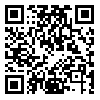Volume 15, Issue 1 (3-2015)
Modares Mechanical Engineering 2015, 15(1): 31-38 |
Back to browse issues page
Abstract: (6740 Views)
When two bodies slide on each other, friction is created. By superposing ultrasonic oscillation to one of the bodies, the friction force is reduced .This phenomenon is widely used in metal forming and metal cutting. For the production and transmission of ultrasonic vibrations to a target it is required to use an ultrasonic system the components of which are a generators, a transducers and a horn. Horn constitutes an important part of the Ultrasonic systems. The main task of the horn is to transmit the ultrasonic vibrations and amplify the ultrasonic vibration amplitude at the output. In this study, an Aluminum horn was designed in cylindrical-conical-cylindrical shape geometry and was analyzed by the finite-element method(FEM) using the Abaqus software was manufactured. The resonance frequency obtained in Abaqus was equal to 19976 Hz. The resonance frequency obtained from the generator was equal to 19920 Hz. Hence there is a very good agreement between the experimental result and the FEM simulation. The difference between the finite element simulation results and the experimental ones is less than one percent. Moreover, a horn –workpiece assembly for applying the ultrasonic sliding friction was designed and manufactured. Then the fixture and the tool holder clamp were designed for the vibrating tool so that it can be installed on a milling machine and the friction force measurement is possible while the ultrasonic vibrations are applied.
Keywords: Cylindrical-conical-cylindrical horns, FEM Simulation, Ultrasonic Vibration, process sliding friction
Article Type: Research Article |
Subject:
Manufacturing Methods
Received: 2014/08/15 | Accepted: 2014/09/27 | Published: 2014/11/22
Received: 2014/08/15 | Accepted: 2014/09/27 | Published: 2014/11/22
| Rights and permissions | |
 |
This work is licensed under a Creative Commons Attribution-NonCommercial 4.0 International License. |


